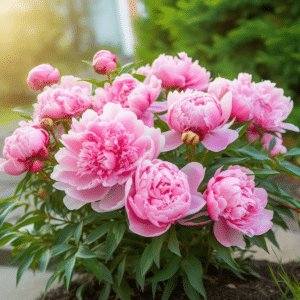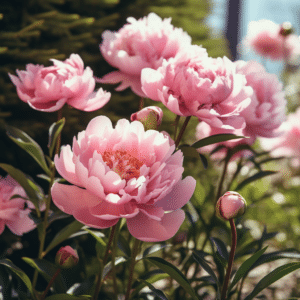Peonies are a popular choice among gardeners due to their stunning blooms and lush foliage. These perennial plants are known for their hardiness and longevity, often outliving their gardeners. With the right care and conditions, you can successfully grow peonies in your garden. This guide will provide you with detailed instructions on how to grow peonies.
Understanding Peonies

Peonies are native to Asia, Europe, and Western North America. They belong to the Paeonia genus and are divided into three main types: herbaceous peonies, tree peonies, and intersectional peonies. Each type has its unique characteristics and care requirements.
Herbaceous peonies are the most common type. They die back to the ground in winter and re-emerge in spring. Tree peonies, on the other hand, are woody shrubs that lose their leaves in winter but retain their structure. Intersectional peonies are a hybrid of the two, combining the best traits of both types.
Choosing the Right Variety
There are over 3,000 varieties of peonies, each with its unique color, shape, and size. When choosing a peony variety, consider your climate, soil type, and personal preference. Some popular varieties include ‘Sarah Bernhardt’ with its large, pink blooms, and ‘Karl Rosenfield’ known for its deep red flowers.
It’s also important to consider the bloom time. Peonies bloom from late spring to early summer, but the exact timing varies by variety. By choosing varieties with different bloom times, you can extend the peony season in your garden.
Planting Peonies
Peonies are typically planted in the fall, about six weeks before the ground freezes. This gives the plants enough time to establish their roots before winter. However, container-grown peonies can be planted in spring or early summer.
Choose a sunny location with well-draining soil. Peonies prefer a soil pH between 6.5 and 7.5. If your soil is too acidic or alkaline, amend it with lime or sulfur, respectively. Peonies should be planted so that the eyes (buds) are no more than 2 inches below the soil surface. Planting them too deep can prevent them from blooming.
Spacing and Watering

Peonies need space to grow. Plant them at least 3 feet apart to allow for good air circulation and prevent disease. After planting, water thoroughly and continue to water regularly, especially during dry periods. However, avoid overwatering as this can lead to root rot.
Peonies also benefit from a layer of mulch to retain moisture and suppress weeds. However, be careful not to mound the mulch around the base of the plant as this can lead to stem rot.
Caring for Peonies
Peonies are relatively low-maintenance plants, but they do require some care to thrive. Regular watering, feeding, and pruning can help ensure healthy growth and abundant blooms.
Feed your peonies in early spring with a balanced, slow-release fertilizer. This will provide the nutrients they need for vigorous growth. Prune back herbaceous peonies in the fall to reduce the risk of disease. For tree peonies, only prune to remove dead wood or to shape the plant.
Dealing with Pests and Diseases
Peonies are generally resistant to pests and diseases, but they can occasionally be affected by fungal diseases like botrytis blight and powdery mildew. To prevent these diseases, ensure good air circulation and avoid overhead watering.
If your peonies are affected by pests like aphids or thrips, you can control them with insecticidal soap or neem oil. Always follow the product instructions for the best
Enjoying Your Peonies
With proper care, your peonies will reward you with a spectacular display of blooms every spring. You can enjoy these blooms in the garden or cut them for bouquets. When cutting peonies for bouquets, do so in the early morning when the buds are still fairly tight.
Peonies also make a great addition to mixed borders, cottage gardens, and even vegetable gardens. They provide structure and color, and their large, fragrant blooms attract pollinators.
Propagating Peonies
If you want to multiply your peonies, you can do so by division. This is best done in the fall, after the plants have gone dormant. Simply dig up the plant, divide the root ball into sections with at least three eyes each, and replant.
With patience and care, you can grow beautiful peonies in your garden. These stunning plants are well worth the effort, providing beauty and fragrance for many years to come.